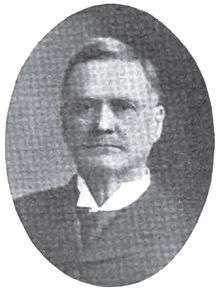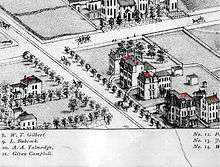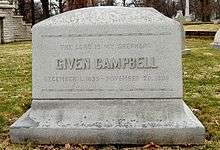Given Campbell
| Given Campbell | |
|---|---|
 Given Campbell | |
| Born |
December 1, 1835 Salem, Kentucky |
| Died |
November 20, 1906 (aged 70) Saint Louis, Missouri |
| Place of burial | Bellefontaine Cemetery |
| Allegiance |
|
| Service/branch |
|
| Years of service |
1861 (Missouri Militia) 1861 (Kentucky Cavalry) 1861–1865 (CSA) |
| Rank |
|
| Battles/wars | |
Given Campbell (December 1, 1835 – November 20, 1906) was a Confederate officer best known for leading the final escape of Jefferson Davis in the last days of the Civil War.
Early life
Campbell was born at Salem, Kentucky to James and Mary (Given) Campbell. Reared in Kentucky, he received his college education at Centre College, Danville, Kentucky and then went to the University of Virginia Law School. Soon after leaving university, he came to St. Louis to begin practicing law and was, for a short time, in the office of Charles D. Drake, later a U.S. Senator from Missouri, and he was admitted to the bar in 1856.
Civil War
When tension over secession increased, Campbell enlisted in the 2nd Regiment Missouri Volunteer Militia under Col. John S. Bowen. He then was elected Captain by the 53 member Company "G". In April 1861 Governor Claiborne Fox Jackson announced a statewide militia muster for early May to gather for their yearly drill and training at a place just outside the city limits of Saint Louis located at Lindell's Grove ostensibly known as Camp Jackson. On May 10, 1861, Given Campbell and 676 other militia men were captured and taken prisoner by Union Captain Nathaniel Lyon and his combined U.S. Army and Home Guard forces. After receiving his parole, Campbell returned to Kentucky where he enlisted as a private in Company "B", 15th Kentucky Cavalry. Soon he was promoted to Captain of the company.
Campbell entered the Confederate Army under General Sterling Price, and served through the war as a cavalryman under Generals Morgan, Forrest, and Wheeler. In the later days of the war, Campbell would serve in Basil Duke's command in the Virginia theater. Following Lee's surrender at Appomattox, Campbell was hand selected by President Jefferson Davis to lead Davis' escape and to choose a few members of Duke's Cavalry brigade to protect his person. Captain Campbell along with the rest of the escort and President Davis were captured at Irwinsville, Georgia on May 10, 1865.
Post-War activities
Given Campbell came back to St. Louis in 1865 and married Susan Elizabeth Woods, daughter of Robert K. and Susan Woods. He found it impossible to practice law in Missouri because of the new "test oath" in the 1865 Drake constitution. He moved to New Orleans where he practiced law and served as a member of the National Democratic Convention of 1872. He came back to Saint Louis in the fall of 1873 and continued in active practice until 1905.


Retiring to Paducah, Kentucky, Given Campbell built a home and lived there a few months. While visiting Saint Louis, Campbell died after a short illness on November 20, 1906 and was survived by his wife and three children, viz: Dr. Given Campbell, Jr; Susan C. Evans (née Campbell), wife of Albert D. Evans; and lawyer James C. Campbell. Given Campbell is buried at Bellefontaine Cemetery in St. Louis, Missouri in Plot Block 112, Lot 56.
References
- Campbell, Given; Wayne Wolf; Paul Faeh; Jack Simmerling. Colonel Given Campbell C.S.A: A Confederate Hero
- Campbell, Given; Wayne Wolf; Jack Simmerling. The Last Civil War Scout. This is a continuation of their work found in Colonel Given Campbell CSA. This details the life of Given Campbell after the Civil War with facsimile reproductions of some of the letters and diaries of Given Campbell and his wife.
- Campbell, Given. Memorandum of a Journal, Kept Daily During the Last March of Jefferson Davis, 1865.
- Conrad, Howard Louis, Ed. Encyclopedia of the History of Missouri. Volume 1.
- Goodspeed, Weston Arthur, Ed. The Province and the States. Volume VII.